A diverse array of owls graces landscapes in Georgia, each with unique characteristics and ecological significance.
Discover the enchanting world of these fascinating birds as we delve into the eight distinct types of owls that call Georgia home.
From the iconic Eastern Screech Owl to the majestic Great Horned Owl, this exploration will introduce you to the various species inhabiting Georgia’s forests, marshlands, and urban areas.
Learn about their distinctive calls, nesting behaviors, and their crucial roles in maintaining the balance of local ecosystems.
Join us on this journey to unveil the remarkable diversity of owls that contribute to the rich tapestry of Georgia’s wildlife, emphasizing the importance of their conservation for the state’s natural heritage.
8 Owls in Georgia
Georgia’s landscapes host an array of owls, encompassing eight distinct species. Join us as we explore these remarkable birds’ characteristics and significance, unveiling their unique roles in Georgia’s diverse ecosystems.
1. Great Horned Owl
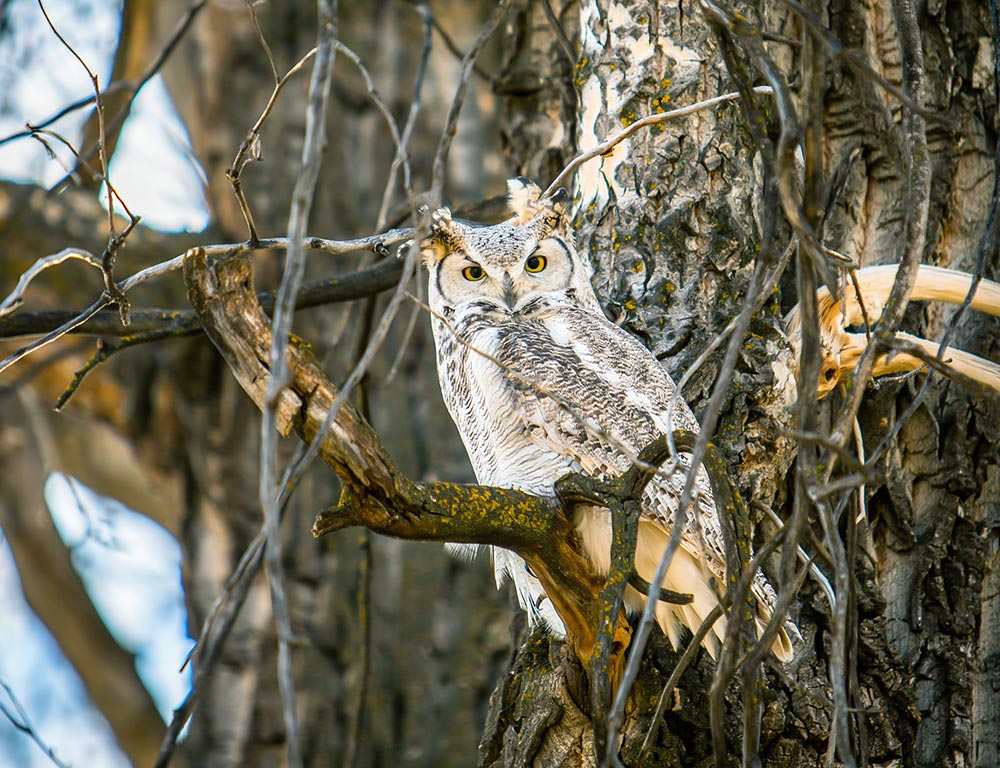
- Scientific name: Bubo virginianus
- Category: Large owl
- Population: Common and widespread.
- Life span: Typically 5-15 years in the wild.
- Size: Adults stand about 18-25 inches tall.
- Weight: Weighs approximately 2-5.5 pounds.
- Food: Carnivorous, preying on mammals, birds, and reptiles.
- Wingspan: Approximately 3.3-4.8 feet.
- Status: Not listed as threatened.
The Great Horned Owl, a formidable and adaptable predator, is common in Georgia’s diverse ecosystems. These owls are powerful hunters with their distinctive “horns” or tufts of feathers on their heads.
They exhibit a wide range of vocalizations, including hoots and screeches.
Great Horned Owls are known for nesting in various locations, including trees and even abandoned nests of other large birds. They are opportunistic feeders, preying on various animals such as rabbits, rodents, and birds.
Their silent flight and excellent night vision make them skilled nocturnal hunters. The adaptability of the Great Horned Owl allows it to thrive in various habitats, from dense forests to open fields.
2. Barn Owl
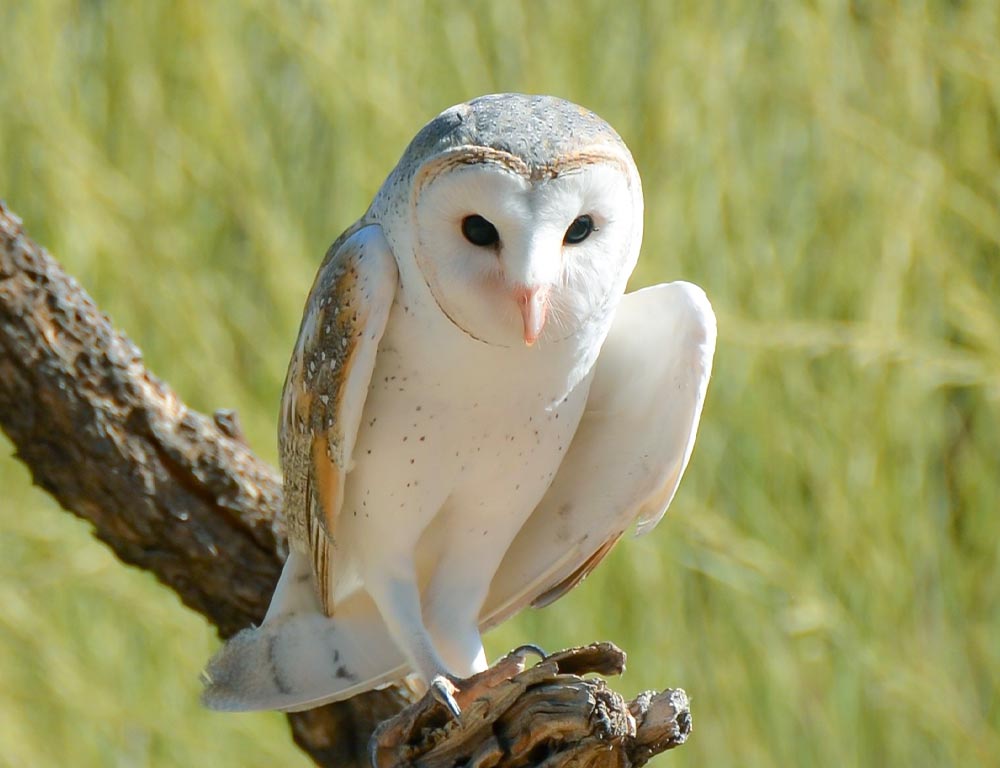
- Scientific name: Tyto alba
- Category: Medium-sized owl
- Population: Widespread, but populations can be locally affected.
- Life span: Typically 1-2 years in the wild.
- Size: Adults have a height of about 12-15 inches.
- Weight: Weighs approximately 1-2 pounds.
- Food: Primarily feeds on rodents, including mice and rats.
- Wingspan: Approximately 3.3-3.8 feet.
- Status: Not listed as threatened.
With its heart-shaped facial disc and ghostly appearance, the Barn Owl is well-adapted for a nocturnal lifestyle. Common in rural areas of Georgia, these owls are efficient hunters of small mammals, especially rodents.
Barn Owls often roost and nest in barns, abandoned buildings, or other structures. Their exceptional hearing and silent flight enable them to locate and capture prey in complete darkness.
While they face some threats, including habitat loss and pesticide exposure, conservation efforts aim to protect these beneficial predators that play a vital role in controlling rodent populations.
3. Barred Owl
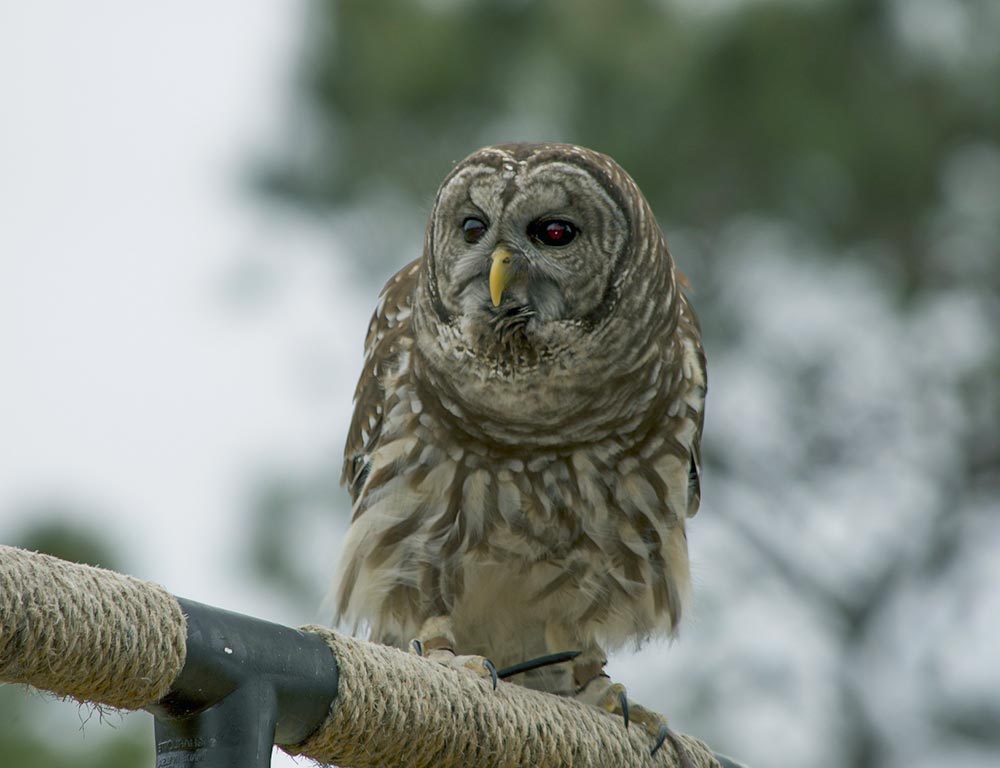
- Scientific name: Strix varia
- Category: Medium-sized owl
- Population: Stable, widespread, and common.
- Life span: Typically 4-10 years in the wild.
- Size: Adults stand about 16-24 inches tall.
- Weight: Weighs approximately 1-2.5 pounds.
- Food: Omnivorous, feeding on small mammals, birds, and amphibians.
- Wingspan: Approximately 3.3-4 feet.
- Status: Not listed as threatened.
The Barred Owl, recognized by its distinctive “Who cooks for you?” hooting call, is a common resident of Georgia’s forests and wooded areas.
With its brown and white barred plumage, these owls are well-camouflaged in their woodland habitats. Barred Owls are adaptable and can be found in both dense forests and suburban areas.
They are opportunistic feeders, preying on small mammals, birds, and amphibians. Unlike some other owl species, Barred Owls are known to be active during the day.
They are cavity nesters, utilizing tree hollows for nesting sites. Their adaptability and broad diet contribute to their widespread distribution and success in various environments.
4. Eastern Screech Owl
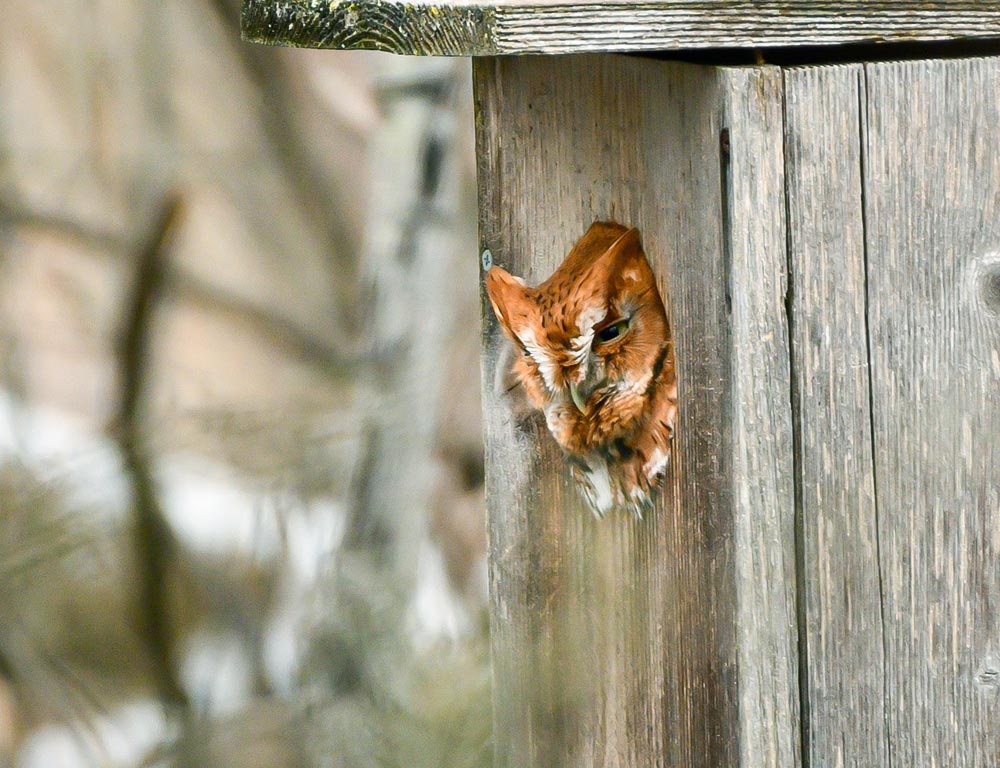
- Scientific name: Megascops asio
- Category: Small owl
- Population: Common and widespread.
- Life span: Typically 4-14 years in the wild.
- Size: Adults have a height of about 6-10 inches.
- Weight: Weighs approximately 4-8 ounces.
- Food: Carnivorous, feeding on insects, small mammals, and birds.
- Wingspan: Approximately 1.5-2 feet.
- Status: Not listed as threatened.
The Eastern Screech Owl, with its distinctive ear tufts and mottled plumage, is a small owl commonly found in wooded areas throughout Georgia.
These nocturnal hunters are adaptable to various habitats, including suburban neighborhoods.
Eastern Screech Owls have a repertoire of vocalizations, including trills and whinnies. They are skilled at perching on branches, patiently waiting to pounce on prey such as insects, small mammals, and birds.
Their cryptic plumage provides effective camouflage against tree bark, aiding in both hunting and avoiding predators. Eastern Screech Owls often use natural tree cavities or nest boxes for roosting and nesting.
5. Short-eared Owl
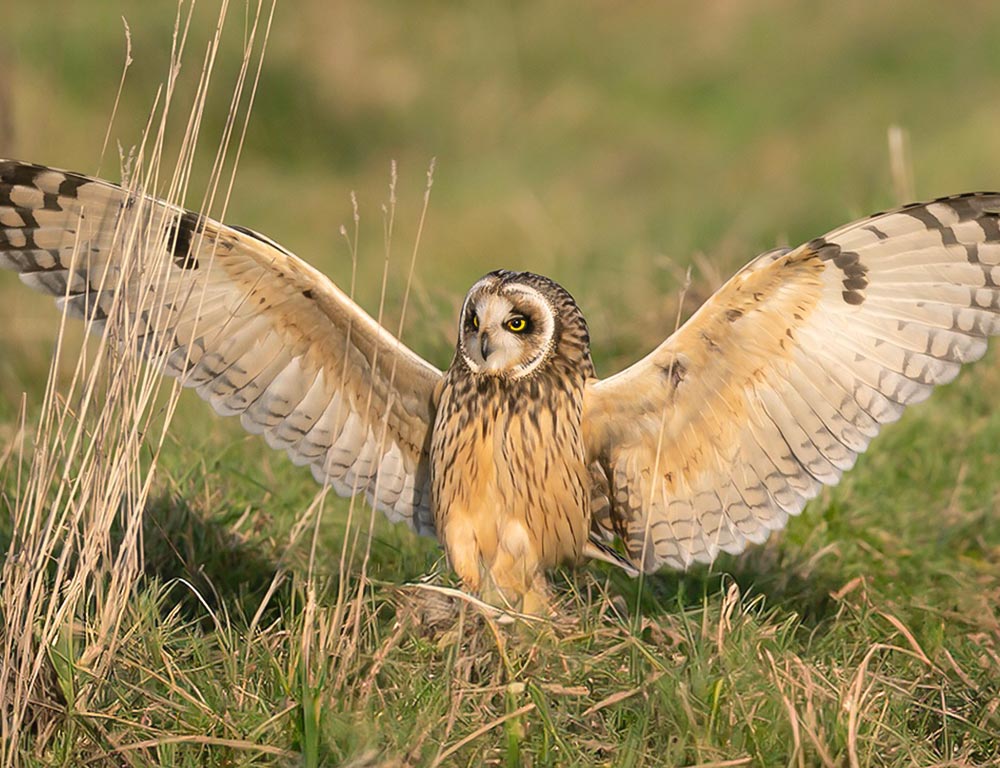
- Scientific name: Asio flammeus
- Category: Medium-sized owl
- Population: Variable, with populations affected by habitat changes.
- Life span: Typically 3-5 years in the wild.
- Size: Adults have a wingspan of about 2.5-3.3 feet.
- Weight: Weighs approximately 7-16 ounces.
- Food: Primarily feeds on small mammals, especially rodents.
- Wingspan: Approximately 2.5-3.3 feet.
- Status: Not listed as threatened.
The Short-eared Owl is a medium-sized owl that, despite its name, does not have long ear tufts. It is a nomadic species found in various open habitats in Georgia, including grasslands and marshes.
Short-eared Owls are known for their diurnal (daytime) hunting behavior, making them unique among owls. They primarily feed on small mammals, especially rodents, and are skilled hunters in flight.
Their population can be variable, influenced by factors like habitat changes and prey availability. During the breeding season, Short-eared Owls perform aerial displays, showcasing their agility and territorial behavior.
6. Northern Saw-whet Owl
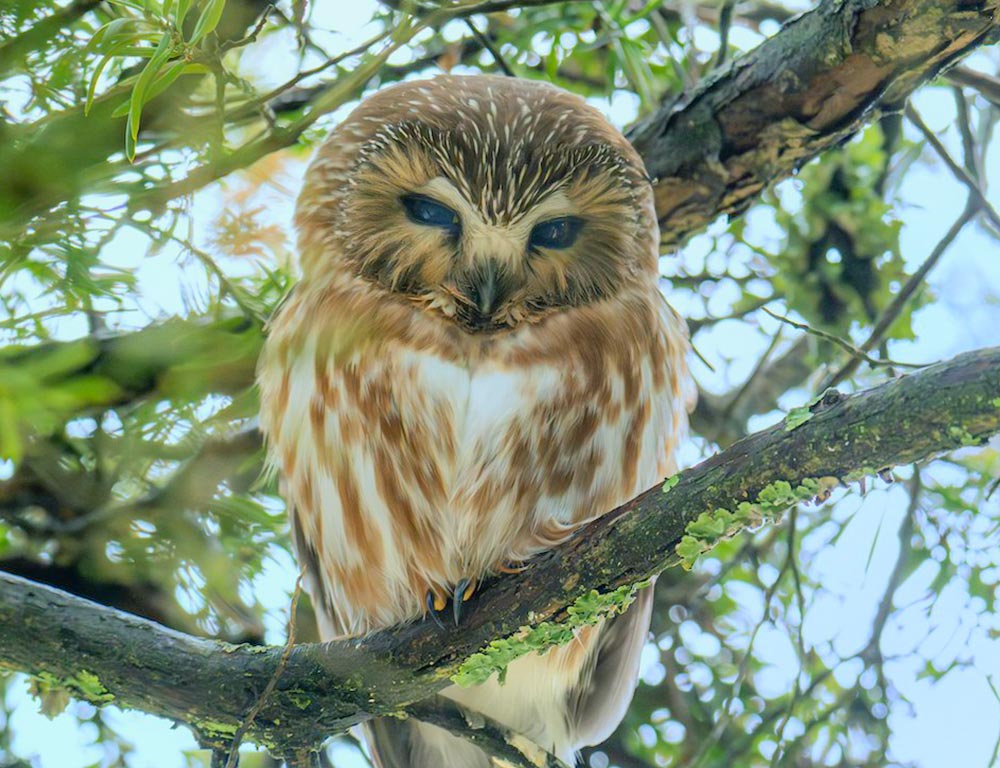
- Scientific name: Aegolius acadicus
- Category: Small owl
- Population: Relatively common but secretive and seldom seen.
- Life span: Typically 3-7 years in the wild.
- Size: Adults have a height of about 7-8 inches.
- Weight: Weighs approximately 2-5 ounces.
- Food: Carnivorous, feeding on small mammals, birds, and insects.
- Wingspan: Approximately 1.5-2 feet.
- Status: Not listed as threatened.
The Northern Saw-whet Owl, a small and secretive owl, is found in forests and wooded areas of Georgia.
Named after its distinctive repetitive call that sounds like a saw being sharpened, these owls are nocturnal hunters. They have excellent camouflage with their plumage matching the bark of trees where they roost.
Northern Saw-whet Owls primarily feed on small mammals, birds, and insects. Despite their small size, they are efficient predators, capturing prey with swift and silent flights.
Northern Saw-whet Owls are cavity nesters, using abandoned woodpecker holes or natural tree cavities. Due to their elusive nature, they are seldom seen, but their presence adds to the biodiversity of Georgia’s woodlands.
7. Snowy Owl
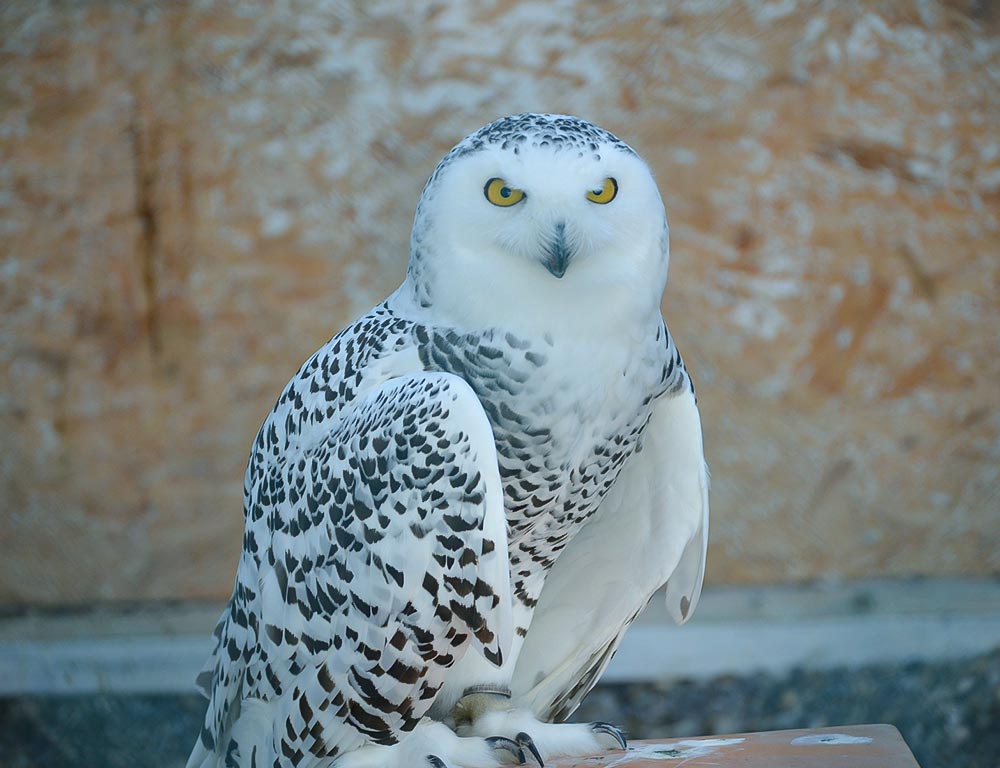
- Scientific name: Bubo scandiacus
- Category: Large owl
- Population: Variable, with significant fluctuations in population numbers.
- Life span: Typically 9-10 years in the wild.
- Size: Adults have a wingspan of about 4.5-5.5 feet.
- Weight: Weighs approximately 3.5-6.6 pounds.
- Food: Primarily feeds on lemmings and other small mammals, also birds.
- Status: Not listed as threatened, but vulnerable to environmental changes.
The Snowy Owl, known for its distinctive white plumage, is an Arctic owl that occasionally migrates southward to parts of Georgia during winter irruptions.
These owls are well-adapted to cold climates and have thick plumage to withstand harsh weather. Snowy Owls are powerful hunters, primarily preying on lemmings and other small mammals in their Arctic breeding grounds.
During winter migrations, they may also hunt birds. Snowy Owls are diurnal hunters, taking advantage of the continuous daylight in the Arctic summer. In the wintering grounds, they may be seen perched on open fields or coastlines.
While not considered threatened globally, they face challenges due to climate change affecting their Arctic habitats and increased human interaction during migration.
8. Burrowing Owl
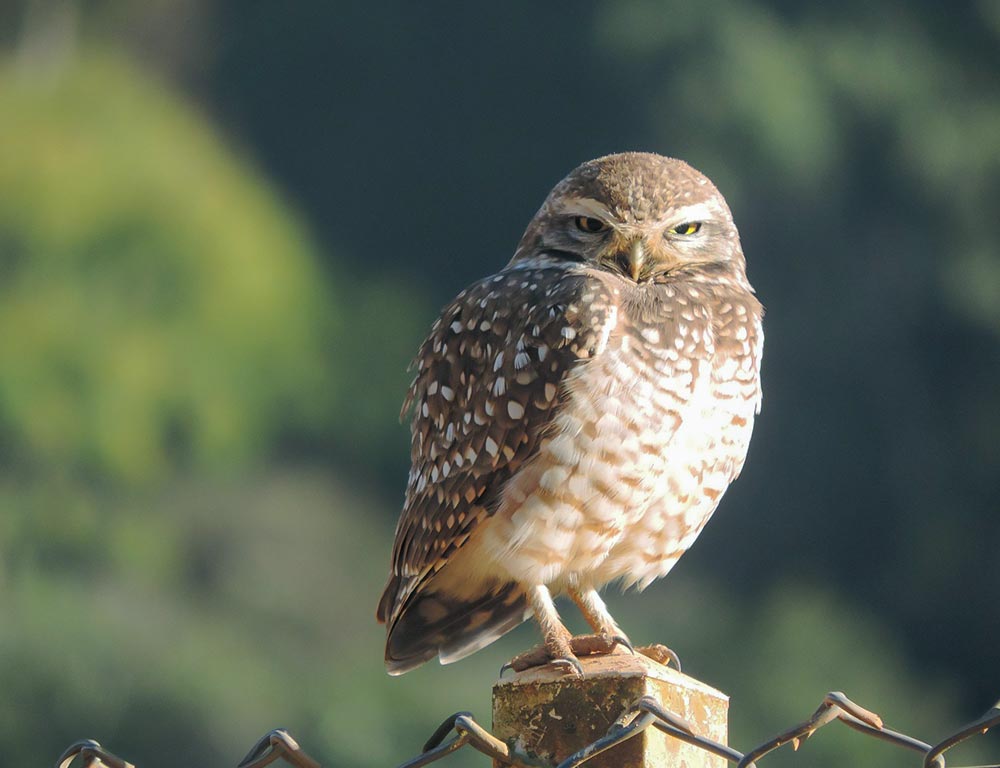
- Scientific name: Athene cunicularia
- Category: Small owl
- Population: Declining in some areas due to habitat loss.
- Life span: Typically 6-8 years in the wild.
- Size: Adults stand about 7-10 inches tall.
- Weight: Weighs approximately 4-7 ounces.
- Food: Primarily feeds on insects, small mammals, and reptiles.
- Status: Not listed as threatened globally, but vulnerable in some regions.
The Burrowing Owl, characterized by its long legs and distinctive behavior, is found in open habitats, including grasslands and prairies, in parts of Georgia.
As the name suggests, Burrowing Owls often nest in burrows, either dug by themselves or appropriated by mammals like prairie dogs.
They are diurnal hunters and display unique behaviors, such as standing on raised mounds near their burrows to scan for prey. Burrowing Owls have a varied diet, feeding on insects, small mammals, and reptiles.
Unfortunately, they face threats from habitat loss due to agriculture and urbanization. Conservation efforts focus on preserving open landscapes and ensuring suitable nesting sites for these captivating owls.
Ecological Significance of Owls in Georgia
Owls play a crucial ecological role in Georgia’s ecosystems, contributing to the balance and health of local wildlife populations. Here are several ecological significances of owls in Georgia:
Rodent Control
Owls are efficient predators of rodents, such as mice and rats. In Georgia, where agriculture is prevalent, owls contribute to natural pest control by keeping rodent populations in check. This helps protect crops and prevents damage to agricultural fields.
Biodiversity Maintenance
Owls are part of the intricate food web in Georgia’s ecosystems. By preying on a variety of small mammals, birds, and insects, owls help regulate the populations of these species.
This, in turn, supports biodiversity by preventing any one species from becoming overly dominant.
Nocturnal Predator
Owls are primarily nocturnal hunters. Their presence helps control the populations of nocturnal prey species, contributing to a balanced distribution of both diurnal and nocturnal animals within ecosystems.
Cascading Effects in Food Webs
Owls are positioned high in the food chain, and changes in their populations can have cascading effects throughout the ecosystem.
A decline in owl populations could increase the abundance of their prey species, impacting vegetation, smaller predators, and other interconnected elements of the ecosystem.
Natural Pest Control in Forests
In Georgia’s forests, owls play a vital role in controlling populations of small mammals, including tree-damaging rodents. By regulating these populations, owls contribute to maintaining the health and balance of forest ecosystems.
Bioindicators of Ecosystem Health
The presence and behavior of owls can serve as indicators of ecosystem health.
Changes in owl populations or their nesting success may signal shifts in prey availability, habitat quality, or environmental contaminants.
Monitoring owl populations can provide valuable insights into the overall well-being of Georgia’s ecosystems.
Seed Dispersal
Some owl species, such as the Eastern Screech Owl, may inadvertently contribute to seed dispersal.
After consuming prey that includes fruits or seeds, owls may transport the undigested seeds to new locations, potentially aiding in the regeneration of plant species.
Educational Value
Owls capture people’s fascination and serve as educational ambassadors for wildlife conservation. Learning about owls and their ecological roles can foster an appreciation for the importance of preserving natural habitats and biodiversity.
Ecotourism and Recreation
The presence of owls in Georgia provides opportunities for ecotourism and wildlife observation.
Birdwatchers and nature enthusiasts may visit areas known for owl populations, contributing to local economies and fostering a connection between people and nature.
Adaptations to Various Habitats
Owls in Georgia are adapted to various habitats, including forests, grasslands, and urban areas. Their adaptability allows them to thrive in different ecosystems, contributing to the ecological balance across diverse landscapes.
Conserving owl populations and their habitats is essential for maintaining the ecological balance in Georgia.
This involves preserving natural habitats, minimizing habitat fragmentation, and addressing threats like habitat destruction, pollution, and climate change.
By recognizing the ecological significance of owls, conservation efforts can be directed toward ensuring the long-term health and sustainability of Georgia’s ecosystems.
Wrapping Up
Owls in Georgia hold profound ecological significance, influencing pest control, biodiversity, and ecosystem health.
As nocturnal hunters, owls contribute to the balance of prey populations, acting as vital components in the intricate web of Georgia’s ecosystems.
Their role as bioindicators and their adaptability to diverse habitats highlight the importance of conserving owl populations. By recognizing their educational and recreational value, we can foster a deeper appreciation for wildlife conservation.
To ensure the continued well-being of owls in Georgia, efforts should focus on habitat preservation, sustainable practices, and public awareness initiatives.
Through these measures, we can celebrate and safeguard owls’ vital contributions to the natural balance of Georgia’s rich and diverse landscapes.